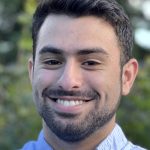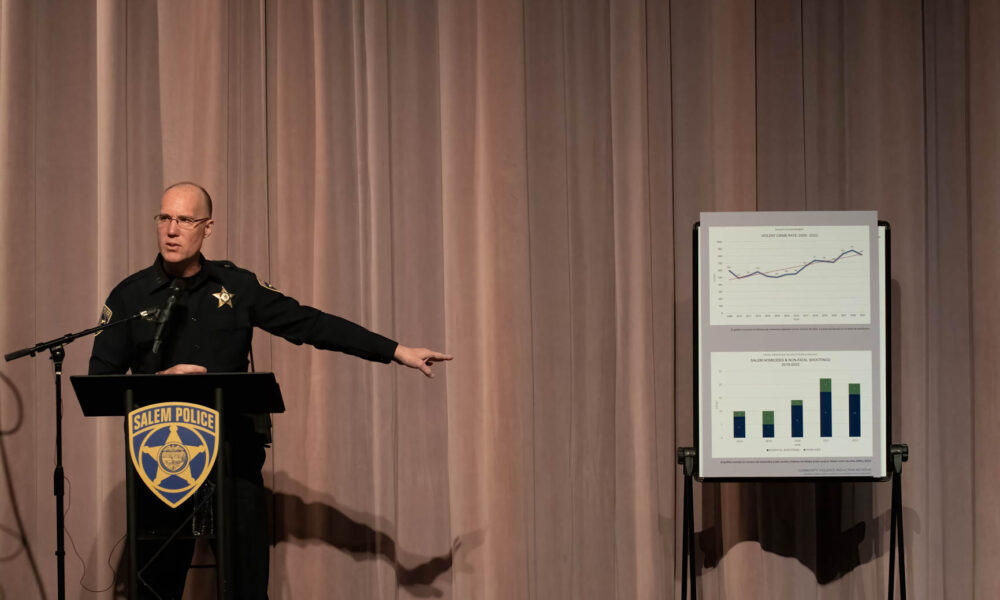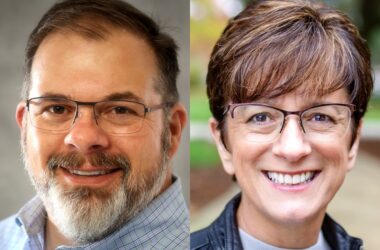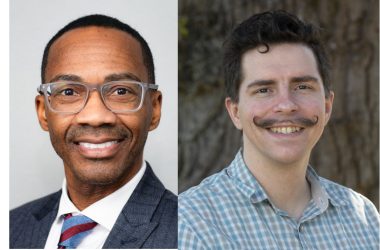Community leaders last week urged Salem officials at a public forum on gun violence to engage Latino residents in their efforts to reduce shootings in the city.
The event on March 6, held at the East Salem Community Center, was the first in a series of public meetings intended to plan ways to reduce shootings with the help of community organizations and people who have experienced lives of violence.
Maricela Lagos, a youth prevention coordinator with the Salem-Keizer Coalition for Equality, walked to the microphone during the Q&A portion. With two moms by her side from the coalition’s parent organizing group, she said the community needs this type of conversation in Spanish.
“We are completely at your disposal to be part of this change,” she said speaking in Spanish. “We are committed to helping our neighborhoods because we all want the same thing, and that is the safety and the academic success of our children.”
Salem police said around 200 people attended the event, which ran about 90 minutes. Womack shared facts about gun violence in Salem. Then, Ben McBride, an activist focused on criminal justice reform and gun violence prevention, spoke about solutions that have worked in other U.S. cities. McBride will facilitate the city’s next community meetings on violence reduction.
McBride said Salem police need to work with community organizations to intervene in the lives of people engaged in violence and prevent those at highest risk from doing so with individualized plans. He shared stories of how similar efforts he led in more than 10 cities across the U.S. resulted in fewer fatal shootings.
Womack also announced that the Marion County Sheriff’s Office is preparing a report on the state of gun violence across the county, including data on unincorporated east Salem that was notably missing in a recent city report.
A report released by Salem officials in November showed that local shootings in recent years were largely concentrated in northeast Salem. But researchers didn’t count parts of east Salem outside city limits such as Hayesville and Four Corners. The new county report will provide data on shootings in those areas.
Womack said he expects the county’s data to be completed and publicly available before the end of the year.
Meantime, city officials are spearheading a Community Violence Reduction Initiative, which will bring together law enforcement agencies and community organizations to focus on preventing shootings. Salem police are assigning newly promoted Deputy Chief Debra Aguilar to lead the agency’s work.
Salem is also hiring for a temporary “violence coordinator” in the city manager’s office to oversee the new program. The position and work related to the initiative would be paid for by salary savings from vacant positions. Womack said the person would help coordinate “community capacity,” including convening future meetings on reducing violence.
Audience members used the public forum to question Womack and McBride about their plans for getting those most at-risk of violence to be part of the solution, keeping Salem’s Latino community involved in their efforts and the timeline of their intervention work.
Womack said the meeting was a first step in developing the community response that Salem needs.
Salem police also handed out notecards in English and Spanish asking for ideas on reducing violent crime and how the person or their organization could help.
The forum came less than 24 hours before a shooting in Bush’s Pasture Park left a teen boy dead and two others wounded.

Womack told the audience that the city’s “North Star” is to reduce shootings.
The chief told Salem Reporter after the event that he didn’t have a specific numeric goal for shootings and arrests. He said that Salem police will continue to track shootings, but a reduction over the long term will be the best measure of success.
The city’s gun violence report showed that one 5-mile-square area of Salem in the northeast has seen the most gun violence in recent years.
Womack said that region only covers about 11% of the city’s geography.
“What seems often to be a large, out-of-control, unmanageable problem, it starts to look a little more manageable when you think about how concentrated this is in this area,” he said.
The report also found that about half of victims and assailants involved in the city’s shootings are Latino.
“I say that because that’s what the data shows us. It’s not about labeling any group, disparaging any group. This is about risk identification, for the equitable redirection or creation of services, to reduce risk,” Womack said. “What that really means is, save people’s lives.”
McBride grew up in Oakland, California, where he worked as a faith and community leader. In 2006, the city of 400,000 people endured 148 homicides and over 500 shootings.
He said he worked with law enforcement agencies at the time to tackle the problem. Oakland, which had averaged 100 homicides every year for four decades, reduced fatal shootings by 50% over five years.
“I’m here a little bit from Salem’s future, if you will, to tell us that we can solve the epidemic of gun violence in our communities, we can save lives, and we can do so even in the areas and the communities where it feels the most difficult to do,” he said.
Law enforcement and community groups in Oakland determined that around 1,000 people belonging to 50 groups were responsible for most fatal shootings. Of those, only around 250 people were actually doing the shooting.
“Once we realized that we only needed to reach 250 people to interrupt their violence and then intervene with the other 750 people that would engage in violence after they were removed, then we realized we had a strategy that we could implement,” he said.
Within the first year of that effort, 39 fewer people died in the city than had been dying on average every year.
“There is a recipe for us to think about how we save lives in our city,” he said.

While trying to create a strategy to reduce gun violence, McBride said it was difficult to get people with different perspectives to sit at the same table, stay there and agree on a plan that would save lives.
He said he believes Salem has the people it needs to collaborate on reducing gun violence.
“The question is, can we co-create what is necessary to save the lives of Salem residents and people across (the) community?” he asked.
When McBride started doing violence prevention work, he said his family’s past experiences made him hesitant to sit with law enforcement. But he eventually realized that the only way to create safe communities was if people who have experienced gun violence worked with criminal justice leaders to create strategies and the resources needed to fund them.
“The work that we did years ago has now become the national model that they’re using across the country,” he said.
McBride said research determined that the people at highest risk of being involved were those ages 18 to 35 who were on probation or parole, had already committed a gun crime and knew somebody who had been shot within the last six months.
“It informed the kinds of strategies where we got a chance to go have a conversation with people and say, ‘You’re at an incredibly high risk to be shot, and we want to figure out how to come up with a very custom strategy to make sure that we save your life, the lives of your children, and make sure that you live a wonderful and fruitful life.’ This is the reason that we’ve got to follow the data,” he said.
McBride said the people closest to Salem’s gun violence problem are also the closest to the solution.
“If we want to stop the shooting, the only way that we’re going to do it is actually to involve people who’ve been proximate to the communities and shooters,” he said. “Everybody doesn’t have to do the same thing, but everybody has to do something.”
Womack suggested an approach similar to Marion County’s Law Enforcement Assisted Diversion program, which works to keep people who are homeless, have addictions or serious health problems from cycling in and out of jail or the emergency room, without their underlying problems being addressed.
Leaders of the program say its success is largely because the “navigators” who work one-on-one with those in need have also in their own past struggled with substance abuse and addiction.
“People that we may consider having some troubled pasts and some challenges in their past that have pulled themselves out of that situation and now are helping others do the same,” the chief said. “We can apply that same line of thinking towards young men, 18 to 35, in our community that are high-risk.”

During the Q&A portion, Amador Aguilar, who leads ENLACE Cross-Cultural Development Corp., said the data should be presented in Spanish for Latino people who are disproportionately impacted by gun violence in Salem.
McBride responded, “I also wonder what it would look like if we could actually make one of the events that we do the primary language be Spanish over English so that the community and the population gets to come and experience it in their heart language.”
The idea prompted applause from the audience.
Another person in the crowd identified himself as the social justice chair of the Unitarian Universalist Congregation of Salem, near the East Lancaster neighborhood. He invited those involved in the violence reduction effort to sit around a table and discuss the issue.
In other cities, McBride said he has four times a year gathered with law enforcement officials, formerly incarcerated people, mothers who have lost their kids to violence, and people who were at high risk or “actively shooting at others,” he said.
“The rate of people making decisions in that meeting to put the guns down and choose life was at 70%.”
McBride said he also started an event in Oakland called “community night walks.” Every Friday, around 25 to 75 residents would walk through neighborhoods experiencing the most gun violence and build relationships with people who were impacted. They’ve been going for 12 years.
“It’s something now that has activated (the) community, and then when it’s necessary to actually vote to fund a measure to resource a gun violence prevention strategy, you’ve built enough cachet in the community for people to lean in,” he said.
Another audience member asked Womack if Salem police have already started intervening with people who have been identified as shooters in the community.
Womack said there is a gap in that process, and the community as a whole needs to decide how they want to handle intervening in and preventing gun violence.
“That’s why I’m engaging in this conversation,” the chief said.
“We need to identify as a community how we want to do intervention and prevention with folks at high risk that doesn’t necessarily just involve enforcement,” he said.
“How are we going to identify those folks at risk and refer or share that information in some way?” he said. “We’ve got to figure that out, then we can have a community-based intervention process that’s much more effective, and keep us in our lane of just solving crimes.”
RELATED COVERAGE:
PHOTOS: Mayor, police chief convene meeting in east Salem on reducing violence
Mayor, police chief to hold community meeting Wednesday on reducing gun violence
Contact reporter Ardeshir Tabrizian: [email protected] or 503-929-3053.
SUPPORT OUR WORK – We depend on subscribers for resources to report on Salem with care and depth, fairness and accuracy. Subscribe today to get our daily newsletters and more. Click I want to subscribe!

Ardeshir Tabrizian has covered criminal justice and housing for Salem Reporter since September 2021. As an Oregon native, his award-winning watchdog journalism has traversed the state. He has done reporting for The Oregonian, Eugene Weekly and Malheur Enterprise.









